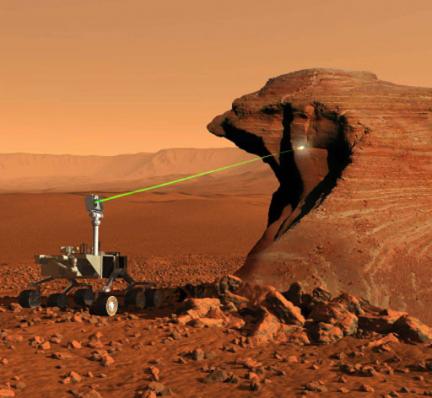
The coming Mars Science Lab mission will be employing a most unusual device for examining the surface of another planet. When MSL reaches Mars around 2010 it will be rolling about the surface of Mars zapping rocks and soil with an on-board laser beam generator. The beam is part of a science package that practices laser-induced breakdown spectroscopy, or LIBS for short. First, scientists on the ground will determine which objects or features imaged with normal on-board cameras seem worthy of further examination. Once a target is selected, a beam is generated and focused upon a small area of that target. This will burn or superheat the material into a plume of particles that expands at supersonic speeds as it cools. It is at this cooling time that the spectrometer will image the cloud and use the widest range of electromagnetic wavelengths possible — from infrared light through visible light and all the way to the ultraviolet. Since every element we know of has a signature of some wavelength within that wide range, the spectrometer will be able to determine all the materials present in the sample (even to simple trace amounts) by detecting and imaging the specific wavelength signatures present in the cloud.
What is most exciting about the instrument is that it is yet another example of NASA really employing non-traditional methods of exploring space. Gone are the old flyby probes of the 70’s and 80’s that simply pick a target and speed by with 95% of its mission goals completed in hours. So far this decade, NASA has chased a comet and collected comet dust in a grid of aerogel; intentionally slammed a heavy probe into a comet to form a man-made crater; they delivered 2 rovers to the surface of Mars that got there from a bounce landing; performed an impromptu landing of a non-lander type probe on the surface of an asteroid and now we will be shooting rocks on Mars. It provides us hope that once we are through the current financial speed bump of retiring the Shuttle fleet and completing our International Space Station commitments we can expect some really exciting new missions to our extended Solar System family. Some have already suggested such missions like air-probes on Mars and Saturn’s Titan; more aerogel collector type missions at Saturn’s Enceladus to collect geyser dust and most exciting of all would be a tunneling probe that could melt its way through the icy crust at Jupiter’s Europa in order to release a submarine type probe into Europa’s vast underground ocean.
It is stunning when you consider the near perfect scorecard for NASA’s unmanned space missions in the last 10-15 years and yet the organization is currently saddled with the image of being ineffective, stodgy and even sloppy. All these perceptions are coming from the manned side of its operations which hasn’t really done anything inspirational since apollo and the initial shuttle years. If only NASA was able to transfer some of the bold ambitions of the unmanned wing of its operations to the manned side of things, then maybe this image could just go away. I propose that even with the occasional tragedy and loss of life (which is inevitable on such endeavors) people would be much more accepting of such losses if astronauts died in the pursuit of doing something remarkable like going to Mars or even the moon for a second time. I mean, who wants to die so that we might hand deliver another component to the space station?
It is high time for us to be inspired by something again… on a grand scale. Time to focus at least some of our attention on something other than the fear of being blown up by terrorists or waging another war on a culture we know so little about. It is truly time to forget about Paris Hilton, forget about reality television and all the other pointless distractions that keep us from dreaming. In many ways it is bigger than just doing science in space — we need to give the next generation something better to think about. Something so exciting that the trivialities of the day that seem to dominate the national consciousness will at least be challenged by something so great that it will be hard to ignore.
We need to get going.